Report

Foreword
The retail industry in the Middle East and North Africa (MENA) is on the verge of a pivotal shift. E-commerce is becoming a reality, reinventing consumers’ path to purchase, forming new customer experiences, disrupting business models, and creating growth opportunities for large and small retailers as well as for a new generation of e-commerce pure players.
Prompted by a shortfall in regional e-commerce data and insights, Google and Bain & Company initiated this study with the objective of supporting investors, entrepreneurs, retailers and other ecosystem stakeholders in decision making. The study assesses the current e-commerce market dynamics (on both the demand and supply sides) in MENA to inform the future outlook for the industry while examining various models of e-commerce development in other markets.
Written in collaboration with
Written in collaboration with

E-commerce is the engine of global retail growth
In 2017, the e-commerce industry came to the fore when it surpassed 10% of all global retail sales. Today, e-commerce is a $2.2 trillion market, and it is expanding at an annual growth rate of 24%, four times faster than the global retail sector as a whole. E-commerce is becoming the key growth engine for retail: Its contribution has risen from 7% in 2012 to 39% in 2017, and we expect it to surpass 50% by 2020.
MENA is entering the third phase of digital adoption
Digital adoption in MENA has not followed the path typically seen in other markets. As consumers move online, businesses typically follow suit, enabling a gradual development of the digital ecosystem in areas such as media and e-commerce. MENA’s experience has been different.
Mass Internet adoption in MENA, especially in the Gulf Cooperation Council (GCC), took off around the mid-2000s, mostly driven by smartphones and social media and underpinned by faster Internet speeds. We call this the “digital consumer phase.” Businesses were late to join the digital party. We finally started to see digital taking a more central role in business strategy after 2010, with media coming to the forefront. And the shift has been dramatic. Within the span of just five years, the share of digital media increased from less than 10% in 2012 to more than 30% by 2017. We call this the “digital media phase.”
In March 2017, Amazon announced the acquisition of Souq, the leading MENA e-commerce company, for $580 million. Later in the year, Mohamed Alabbar, chairman of Emaar Properties, launched noon, a new e-commerce venture, with $1 billion of funding backed by the Public Investment Fund of Saudi Arabia. This marked the beginning of a new digital phase in MENA, the “e-commerce phase.”
The MENA e-commerce market is worth $8.3 billion, with significant room for growth
In 2017, the MENA e-commerce market reached $8.3 billion. With an average annual growth rate of 25%, e-commerce in the region has been growing slightly ahead of the global average. The GCC and Egypt account for 80% of the e-commerce market, and they have been growing at a 30% annual rate, more than twice as fast as the rest of MENA (see Figure 1).

Globally, e-commerce development differs by country. In China and the most advanced Western markets, such as the UK, US, France and Germany, the e-commerce penetration of total retail sales surpassed 10%, reaching nearly 16% in the case of the UK. By contrast, the e-commerce penetration of total retail sales in some other markets, such as Brazil, Turkey and India, is still below the 5% mark.
In MENA, the e-commerce penetration of total retail sales averaged 1.9% in 2017, with the GCC at 3%. The United Arab Emirates (UAE) is the most advanced e-commerce market in the region, with a penetration rate of 4.2%, similar to that of Turkey and Brazil. The Kingdom of Saudi Arabia (KSA) at 3.8% closely follows the UAE. At 2.5%, Egypt’s e-commerce penetration of total retail sales is comparable to that of India and Indonesia (see Figure 2).
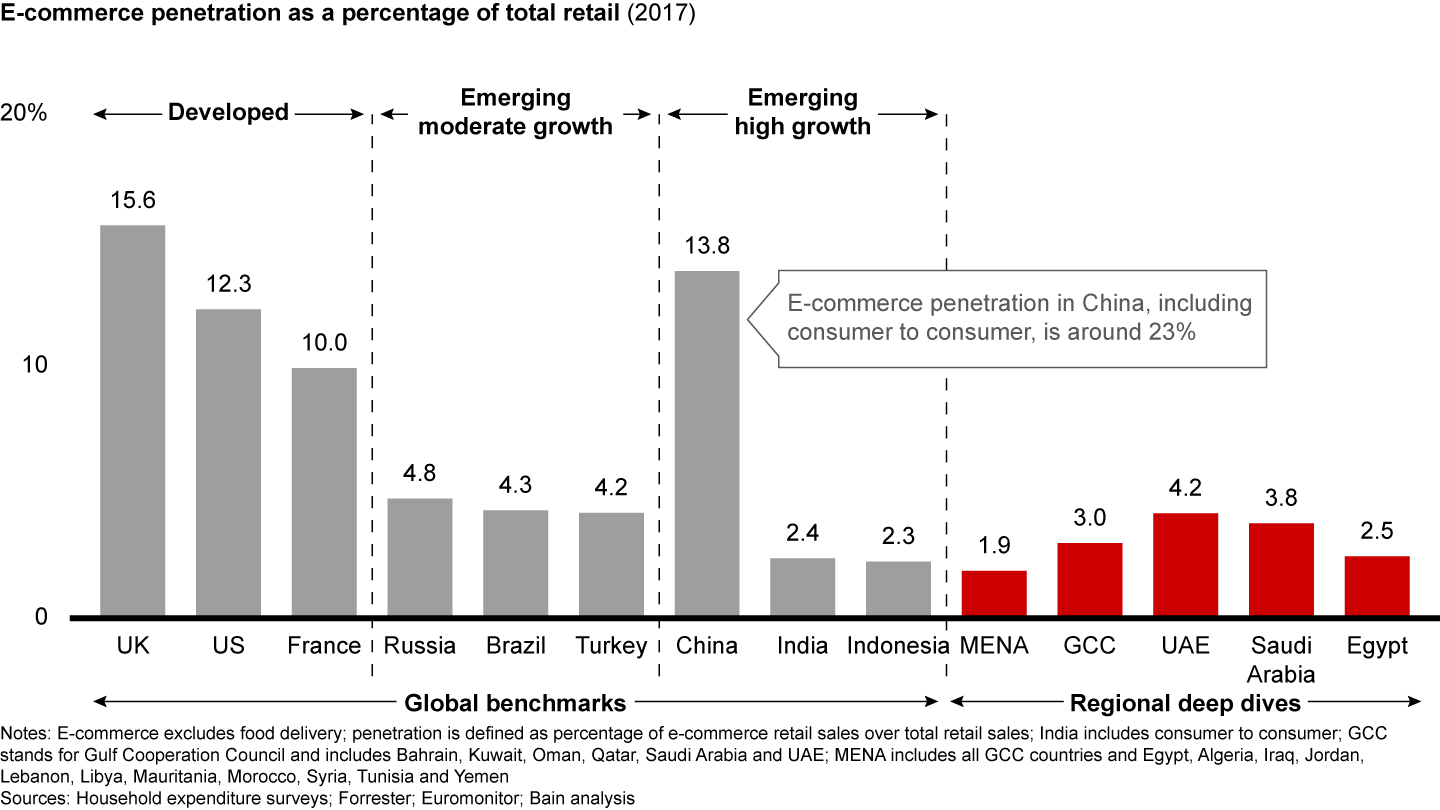
With the global context in mind, the MENA e-commerce market has significant room to grow over the next few years. Is MENA ready to capture the opportunity that lies ahead?
The MENA consumer is ready for e-commerce
The MENA consumer, and notably the GCC consumer, is among the most connected and digitally savvy in the world. The UAE and KSA have some of the highest levels of Internet, smartphone and social media penetrations globally, while Egypt has one of the highest levels of time spent online (see Figure 3).
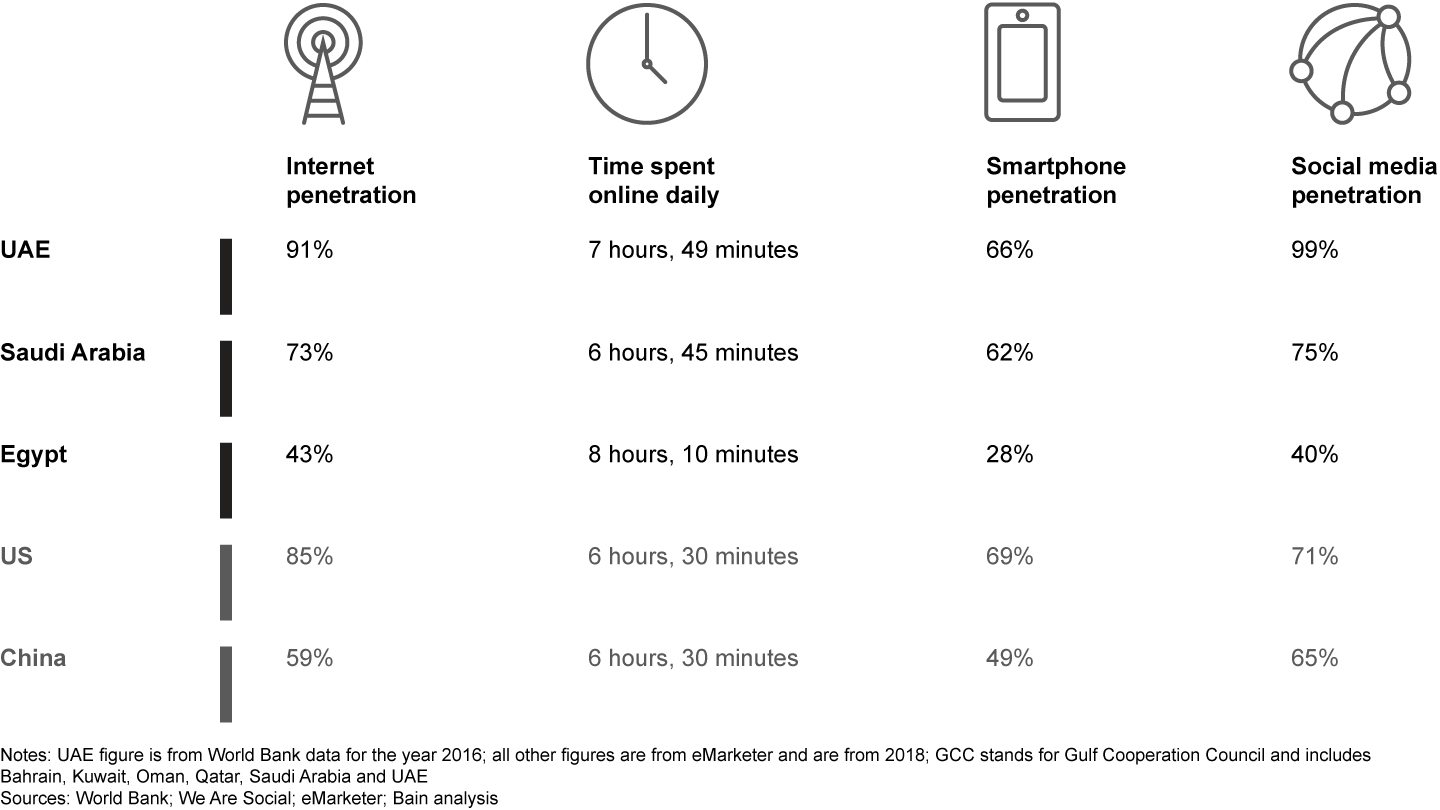
The Internet plays a critical role in consumer path to purchase—discovery, research and actual purchase. Regardless of whether they shop online or in store, consumers in the region are heavily influenced by their online activities (see Figure 4).
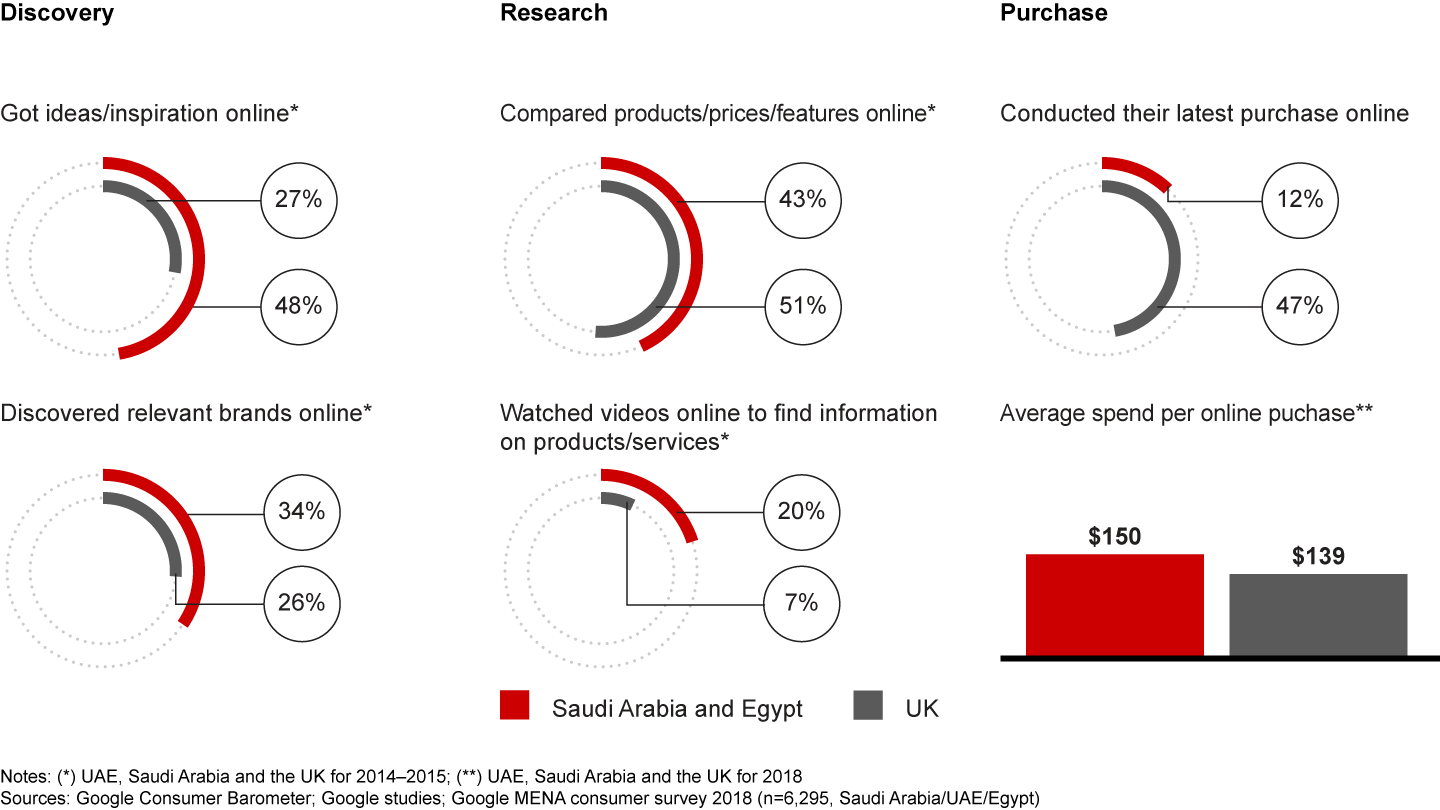
The Internet plays a major role during the discovery process for both online and in-store buyers, with 48% of UAE and KSA consumers getting their shopping ideas and inspirations online. This is nearly double what we see in the UK.
The role of search engines in the research process is instrumental. Almost 56% of consumers in the UAE, KSA and Egypt start their online shopping journeys using search engines as opposed to retailers’ websites. They are constantly searching for products and offers online, with peaks in interest during key seasonal shopping events (see Figure 5). Regional shoppers are more open to choice when researching online compared with other markets. They tend to conduct more generic and less brand-specific search queries. For example, 43% of Google Search queries in the apparel segment in the UAE and KSA are generic and not brand related, compared with 32% in the UK.
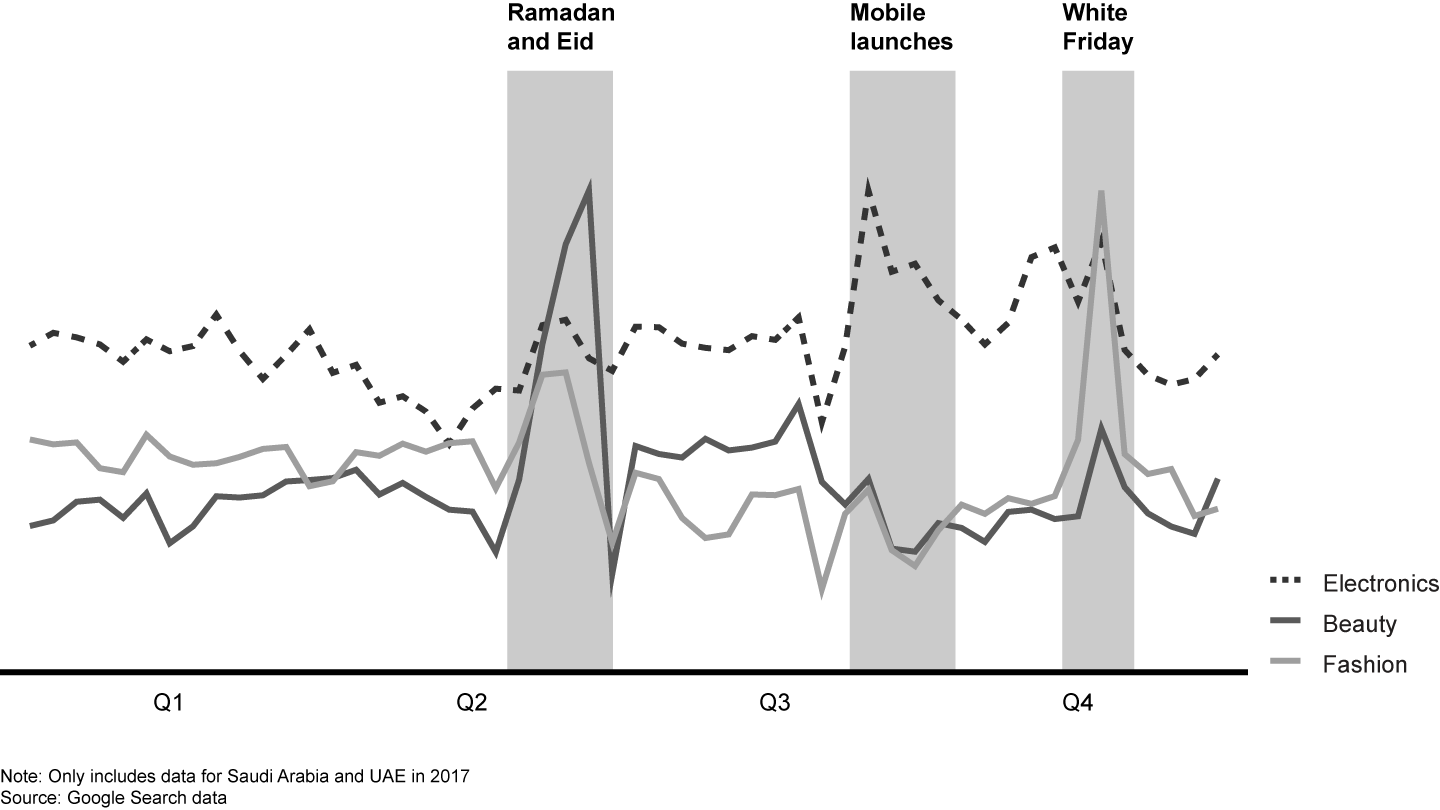
The role of video in the consumer path to purchase in the region is also important, reflecting the overall prominence of online video in the digital life of MENA Internet users. In the UAE and KSA, 20% of consumers watch online videos when researching products and services vs. 7% in the UK. Based on research conducted with women in KSA, YouTube introduced 50% of shoppers to a new brand, and 70% of shoppers follow brands they are interested in on YouTube. As a result, one in two shoppers visits a retailer’s physical store or e-commerce channel after watching a YouTube video.
Consumers in the region are mobile first, with smartphones being the preferred screen for online research and shopping. In the UAE and KSA, the mobile share of shopping-related search queries has reached 70%. The majority of shoppers (55%) in the UAE, KSA and Egypt prefer to use smartphones to shop online.
Shopping online is a natural extension of the digitally savvy MENA consumer’s habits. More than 60% of shoppers in the UAE and KSA and 43% in Egypt have completed an online transaction at least once. This is not far behind more developed e-commerce markets, such as the US and UK, where the e-commerce share of total retail sales is three to four times that of MENA. Moreover, with an average basket size of $150, online shoppers in the UAE and KSA spend just as much, if not more, as their counterparts in the US and UK each time they shop online.
MENA consumers, however, have not yet fully integrated shopping online into their shopping habits. They tend to purchase less frequently online than in store. While the average shopper in the US conducts 19 purchases online annually, MENA shoppers do so only two to four times a year. The low proportion of shoppers who made their last purchase online, 12% in the UAE and KSA vs. 47% in the UK, serves as another example of the region’s low purchase frequency (see Figure 6).
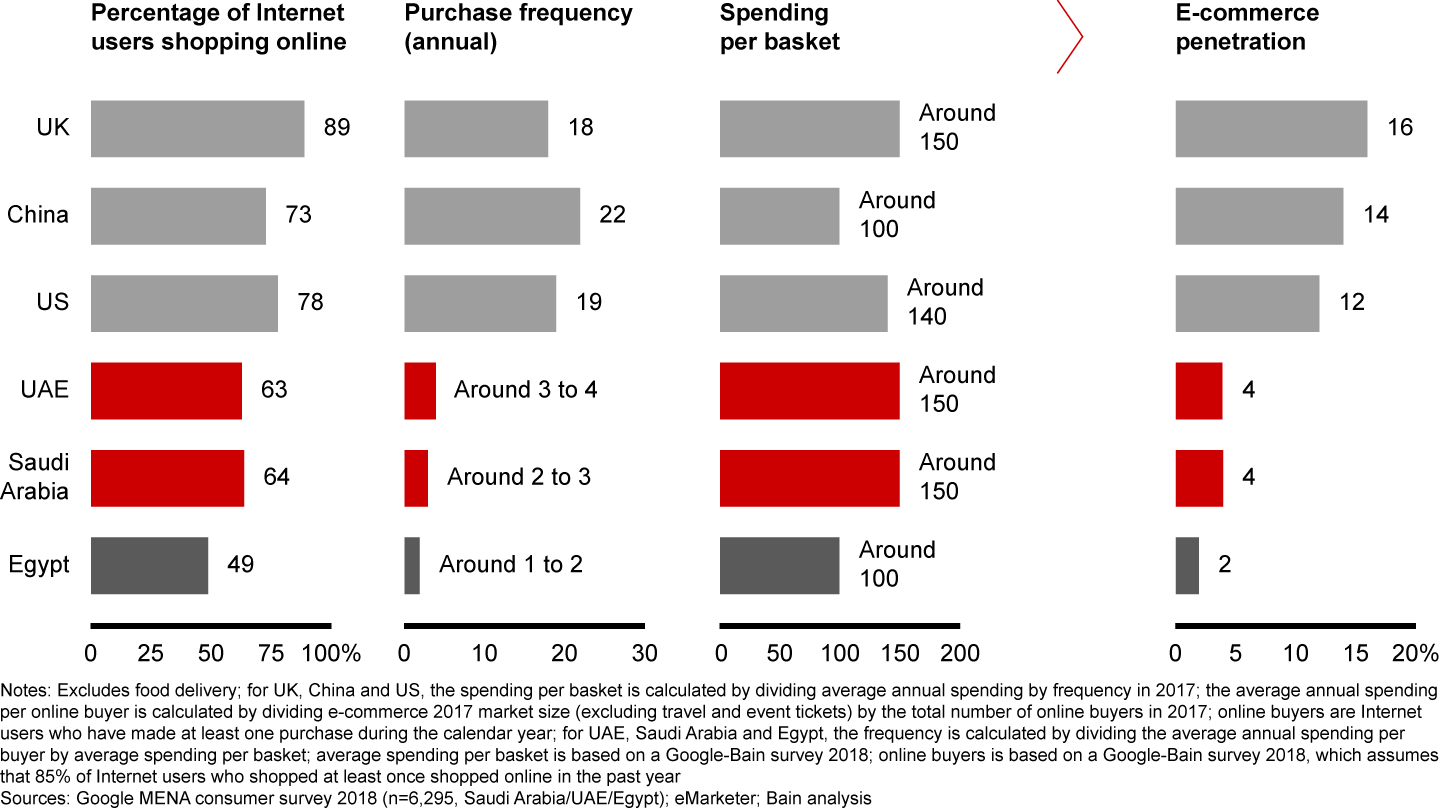
MENA consumers have had few reasons to move more of their purchases online. Limited product selection and inconsistent delivery times and service levels have delayed the takeoff of e-commerce in the region. Recent developments, however, are signaling a change in the trajectory and the beginning of a new chapter in MENA e-commerce.
Online product selection is catching up
Limited access to a broad and deep selection of products has been one of the main challenges hindering the development of MENA e-commerce. The region’s largest e-commerce platform, Souq, offers an estimated 8.4 million products, far fewer than the 550 million offered by Amazon in the US. While the top four e-commerce categories represent half of the US market, these same shopping categories represent 80% of the market in MENA.
A small to medium-sized enterprise (SME) marketplace model has been the backbone of product expansion in most markets. In the US, half of all items purchased on Amazon come from more than a million SMEs. In China, Alibaba managed to enroll SMEs in its marketplace, offering consumers a wide array of online shopping choices. This has not been the case in MENA. While SMEs constitute around 90% of registered companies in the region, they only make up 15% to 30% of MENA’s GDP, which contrasts with the 50% share typically seen in developed markets. They have also been slow to move online.
Large groups, especially in core categories such as fashion and electronics, historically have dominated the MENA retail industry. Most of these groups have been late in making the vast product selection offered in their brick-and-mortar stores available online. It is estimated that less than 20% of top global fashion brands physically present in MENA have locally based e-commerce platforms that offer delivery to the regional consumer.
This demand–supply imbalance in the region has created an opportunity for cross-border e-commerce, with non-MENA-based e-commerce players capturing a significant share of the rising consumer interest in online shopping. As of 2017, cross-border e-commerce represented nearly 50% of the market in the GCC vs. less than 13% in the UK and 6% in the US (see Figure 7).
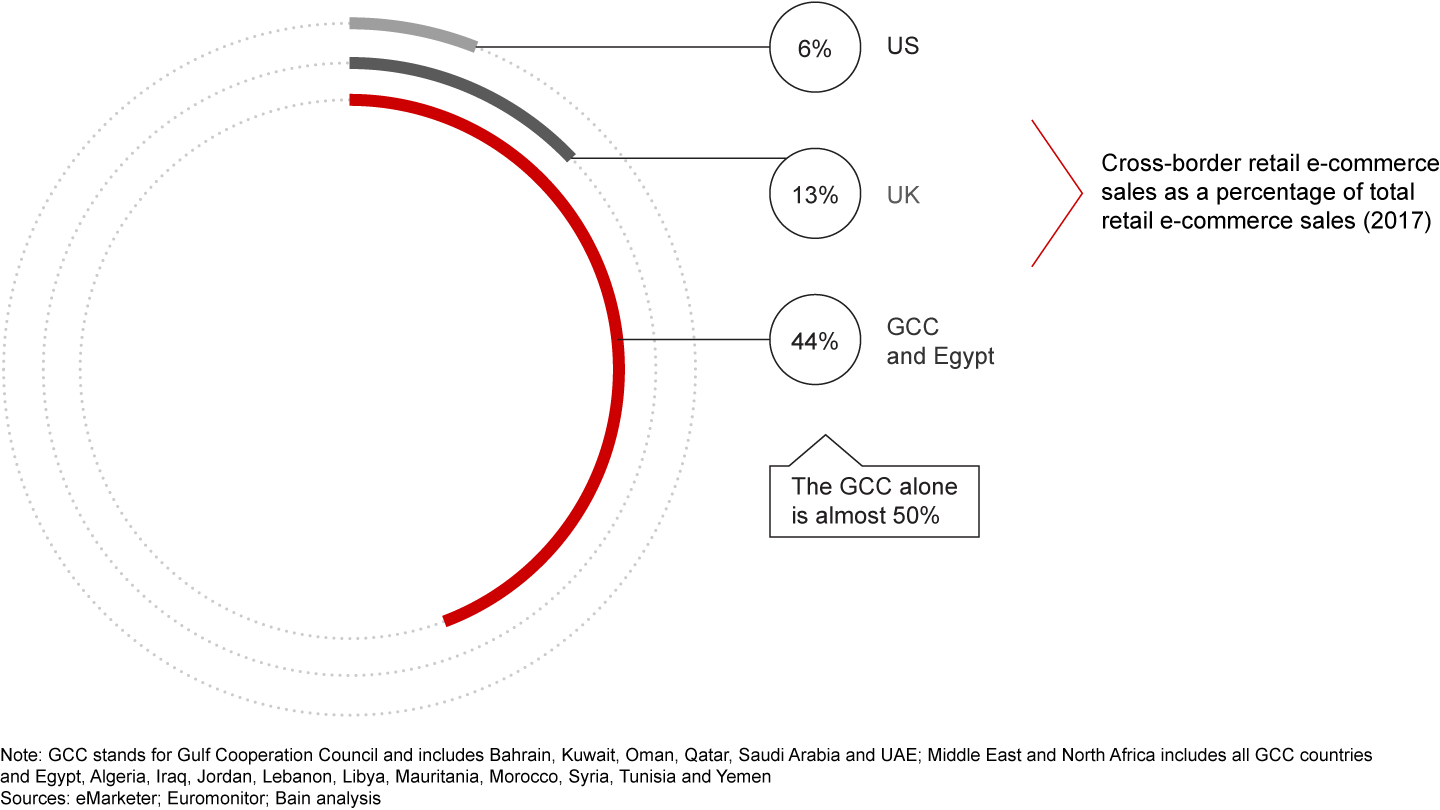
Amazon, eBay and AliExpress are a case in point. These global e-commerce players have been actively marketing to MENA consumers in the general merchandise category. Popular global delivery services, such as Aramex’s Shop & Ship, which offers MENA online shoppers a local delivery address in major cities around the world and facilitates shipping to the region, have supported global e-commerce activity in MENA.
The fashion category has been particularly favorable to cross-border e-commerce, with players such as Yoox Net-a-Porter (YNAP), Farfetch and Asos actively targeting MENA consumers and offering fast and inexpensive shipping and return options (two-day delivery and free returns in most cases). China-based players have significantly grown in the high street fashion category by investing in local marketing strategies and customizing their business models with Arabic websites, local warehousing, fast shipping options and convenient return policies. In KSA, the number of Google Search queries for Chinese e-commerce players such as JollyChic and Shein have seen 60% annual growth over the past three years, making them among the most popular e-commerce destinations in the market. (JollyChic has recently received a Series C round of funding, with a reported $1 billion valuation from Sequoia Capital. This is a significant development for an e-commerce platform heavily focused on the GCC market, particularly KSA.)
Regional retailers and e-commerce pure players have also taken notice of the demand–supply imbalance and the significance of the e-commerce opportunity. The region is starting to see a step change in the availability of products online.
Over the past couple of years, e-commerce has become one of the top strategic priorities for the largest retail groups in MENA. Moving from a physical to an omnichannel model, these groups have invested significant resources in launching more than 35 new e-commerce channels since the beginning of 2017. These include brands such as Ounass, Nisnass, H&M, Mothercare, HomeCentre, Centerpoint, 6th Street, Ace, Lacoste, Swarovski, Level Kids and CarrefourNow, to name a few. Some of them collaborated with global e-commerce players to accelerate their go-to-market strategies. Chalhoub Group joined forces with Farfetch to launch an Arabic website, curate goods for MENA consumers and increase local product selection by adding Chalhoub’s own concepts and franchise brands to the platform. Mohamed Alabbar’s Symphony Investments entered into a joint venture with YNAP to support the expansion of the global fashion e-commerce player in the region.
E-commerce pure players have also been increasing their product selections, both organically and through partnerships. Souq’s integration with Amazon is underway and promises to bring millions of new SKUs to the market. The company recently launched Amazon Global Store in the UAE and KSA, with a localized website, product selection and payment methods. Building inventory quickly has been a core focus at noon. The company has forged partnership deals with the retail groups eXtra and Alshaya to shore up its electronics and fashion offerings. Through its partnership with eBay, noon promises to make buying millions of new products more convenient for MENA shoppers. With the expansion of its manufacturing and logistics capabilities in China, the company is paving the way for a broader product selection and leveling the playing field with China-based players targeting the region.
“Penetration is low today largely due to gaps in the supply. E-commerce is still new in the region, but we are at a turning point with a very exciting 12 months coming ahead.” Faraz Khalid, CEO, noon
The MENA e-commerce market is relatively fragmented
Souq was the first entrant to the MENA e-commerce market and continues to be the market leader. However, the market remains relatively fragmented, with the top two e-commerce players capturing between 25% and 40% of the market. This is in contrast to most other e-commerce markets, where the share of the top two players is typically more than 50% (see Figure 8).
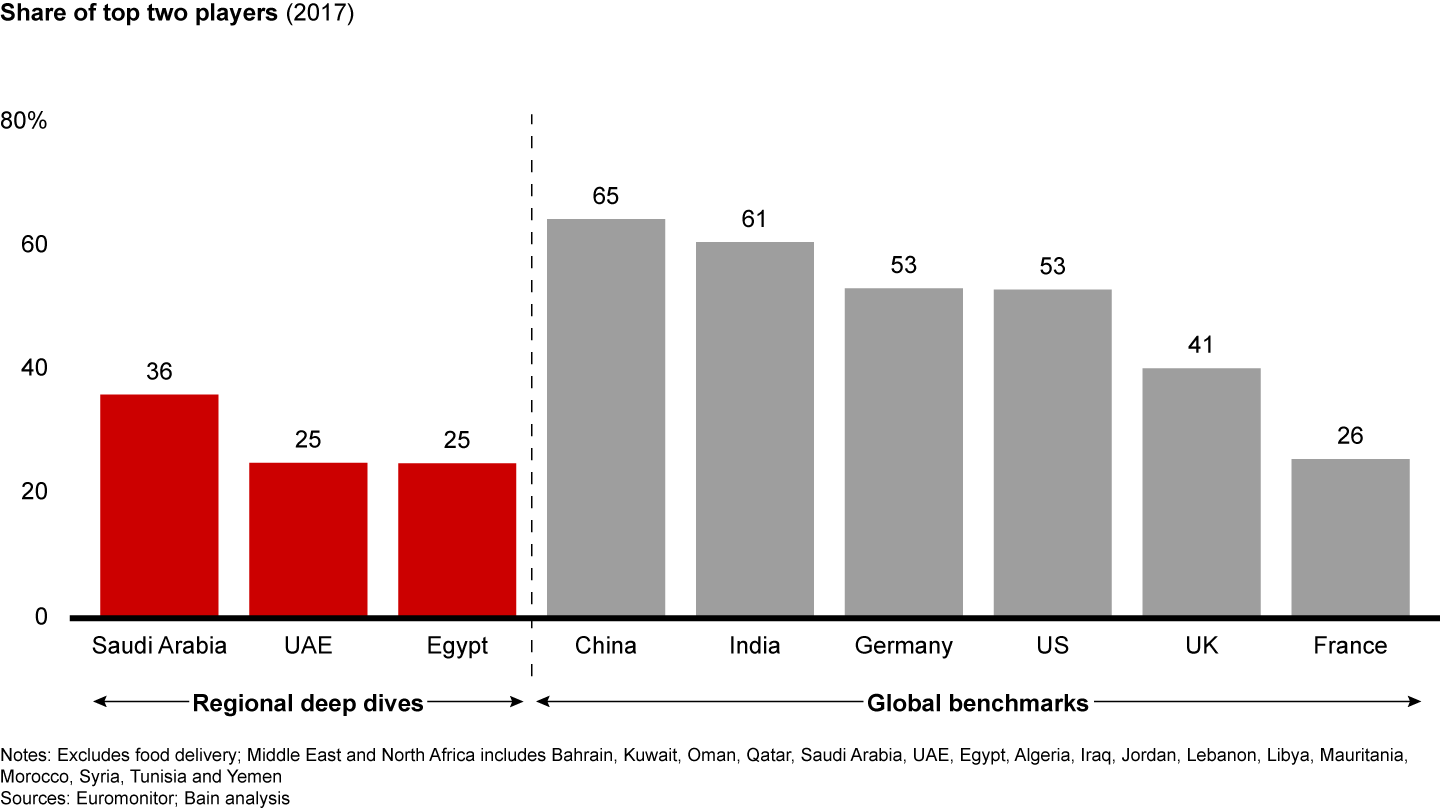
As the e-commerce market develops and competition intensifies, some markets have seen a movement toward consolidation. India is a case in point. In 2005, India was a nascent e-commerce market, with a large number of players, including Flipkart and Myntra, competing for market leadership. The market has since consolidated, with Amazon and Flipkart holding more than 60% of the market share. Amazon has deployed significant investments since entering the market in 2013, and Flipkart has strengthened its position through a series of acquisitions of competitors, such as electronics retailer LetsBuy.com in 2012, fashion retailer Myntra in 2014 and eBay India in 2017.
E-commerce pure players have won the first round, but the game is still on
As of 2017, e-commerce pure players controlled more than 90% of the e-commerce market in MENA, cementing their first-mover advantage.
In most emerging markets where retail infrastructure is relatively underdeveloped, e-commerce pure players have managed to capture the lion’s share of the market (see Figure 9). The case of China is telling. At the turn of the 21st century and in the space of 10 years, China’s middle-class population increased by almost 200 million, creating significant demand for retail products that a historically underdeveloped physical retail ecosystem could not meet. E-commerce came to the rescue. Alibaba’s efforts to address core e-commerce ecosystem challenges in areas such as product selection, payment and logistics paid off, paving the way for e-commerce to scale quickly and address the growing consumer demand. Alibaba and other e-commerce pure players managed to capture the majority of the market along the way.
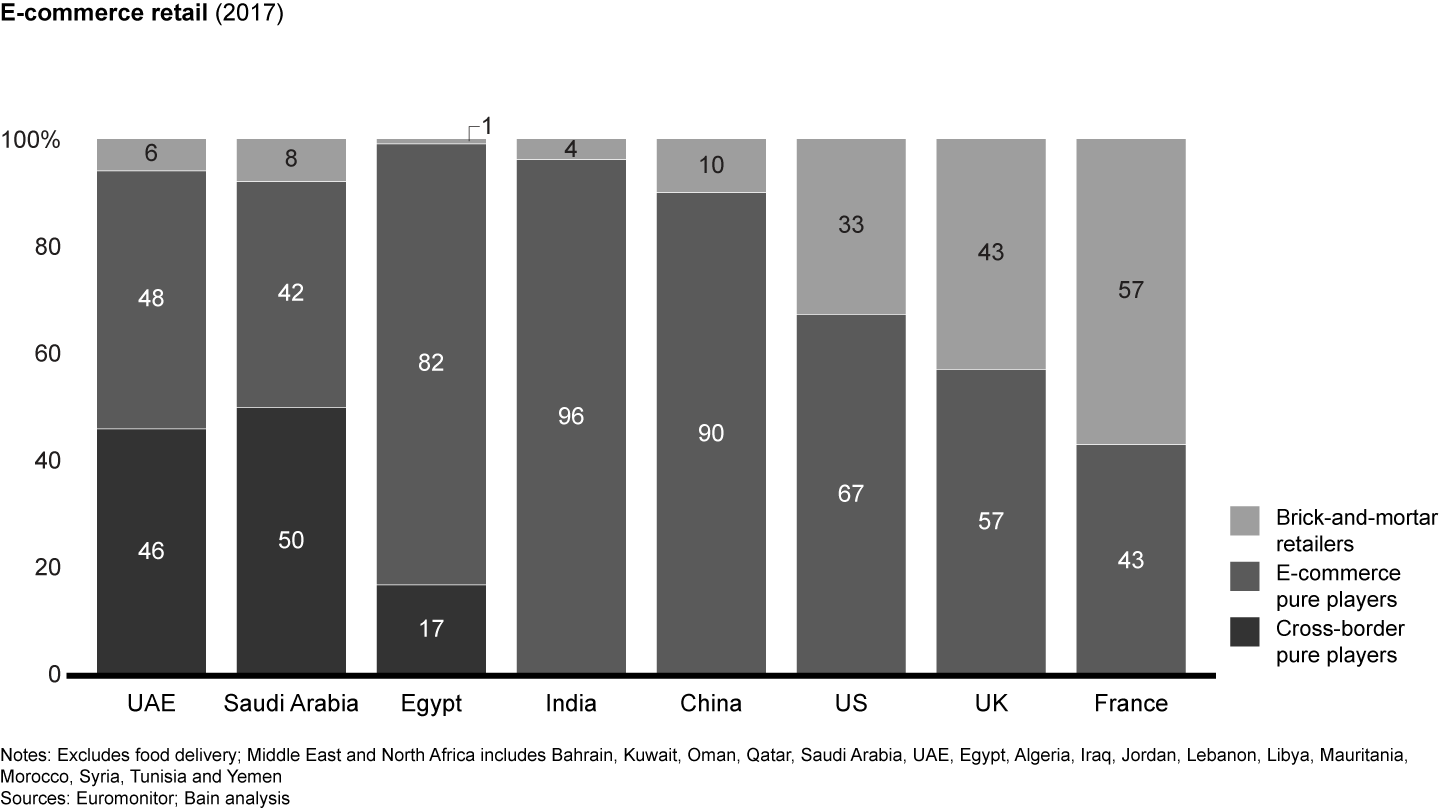
By contrast, traditional retailers in developed retail markets, such as the US and UK, enjoy a strong physical footprint and collectively capture about 40% of market share. While Amazon continues to be the market leader, with almost 50% of the e-commerce share in the US, retailers that moved early on into e-commerce and leveraged their competitive advantage offline into online shopping have been faring particularly well. US retailer Williams Sonoma launched an online shopping presence as early as the turn of the century, and thanks to its catalog heritage, the company was well positioned to collect and use data from customers and other sources in its e-commerce efforts. Williams Sonoma generates nearly 54% of its sales online today. Despite a sluggish start and a less than 4% share of total e-commerce sales, Walmart has recently stepped up its e-commerce investments with the acquisition of Jet.com and a focus on offering a more convenient and integrated online–offline shopping experience, especially in grocery. Walmart is hoping to increase its current share of the e-commerce market.
Brick-and-mortar players in MENA have been following different go-to-market strategies. Alshaya, Apparel Group, Chalhoub Group and Landmark Group established distribution partnerships with third-party e-commerce pure players in addition to launching their own brands online. By contrast, players such as Al Tayer, Al-Futtaim and Majid Al Futtaim focused solely on launching their own e-commerce channels (see Figure 10).
This increasing focus on e-commerce is driving a deep transformation within large retail groups as they transition to an omnichannel model.

“We realized this is not about digital transformation; it’s about transformation, period.” Patrick Chalhoub, CEO, Chalhoub Group
Brick-and-mortar players have the opportunity to leverage their physical distribution networks in the service of their omnichannel strategies in areas such as click to collect and converting stores’ stock rooms into mini distribution centers, reimagining the role of the store from a mere point of sale to a “phygital” experience.
“Stores will have to evolve to become centers of experience that complement new customer journeys and offer digitized services across different touchpoints and in payment.” Hani Weiss, CEO, Majid Al Futtaim Retail
E-commerce is at different levels of development across core retail categories
Not all retail categories in the region are at the same level of e-commerce maturity. While electronics and beauty and personal care enjoy penetration levels closer to those seen in developed e-commerce markets, fashion and grocery are still behind. The room for growth is significant across categories (see Figure 11).
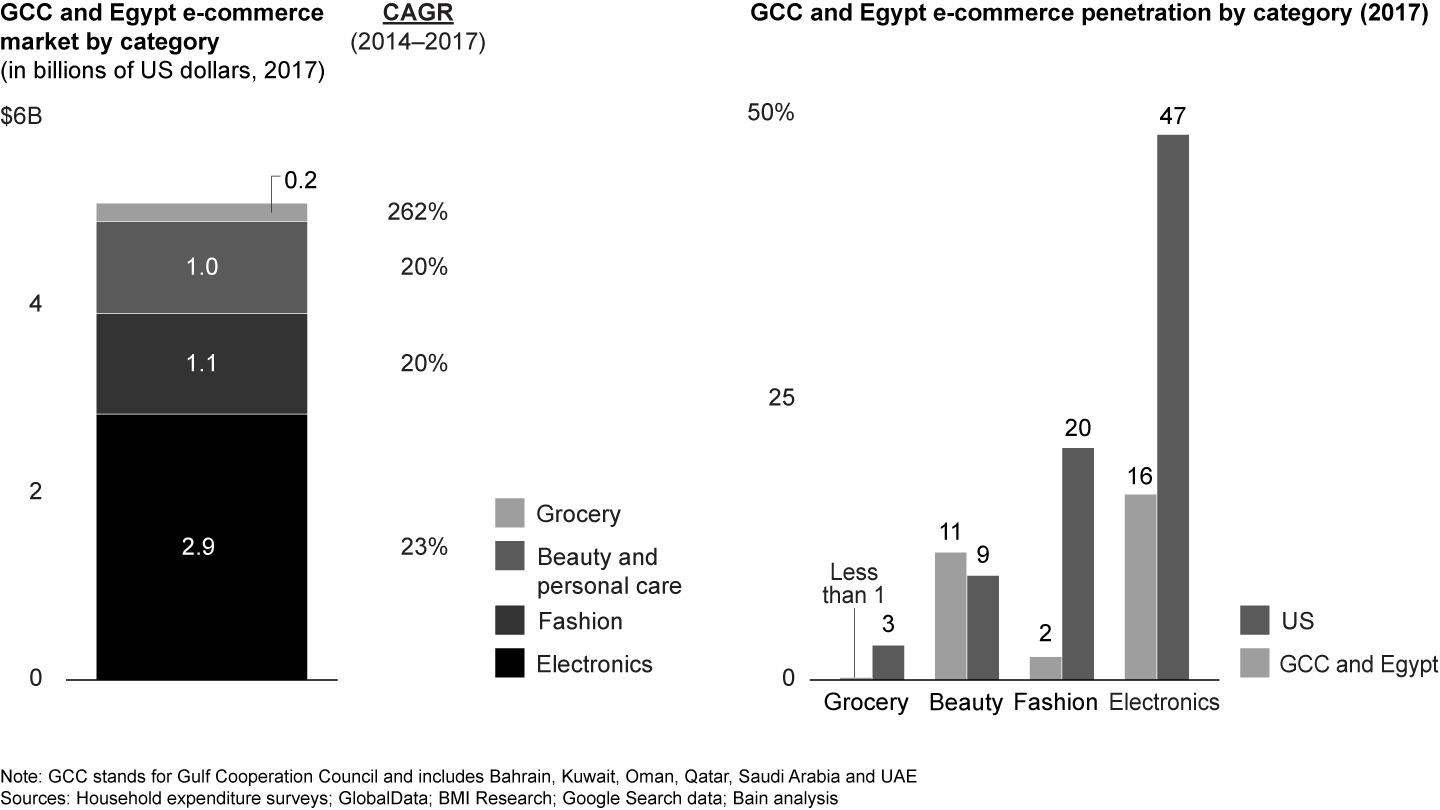
Electronics
Electronics has pioneered the shift to e-commerce in MENA. At $2.9 billion in the GCC and Egypt, it is the largest e-commerce category, and it has been growing 23% annually over the past few years.
On Google Search, electronics-related queries have grown by nearly 30% over the past three years. Electronics is also the most highly penetrated e-commerce category in the region in terms of total retail sales—16% in 2017, up from 10% in 2014. And it has the highest average basket size: $350 online vs. $371 offline.
Nearly 70% of online shoppers in the GCC and Egypt have bought electronics online at least once, mainly using a smartphone (56% vs. 31% using a desktop). While mobile phones make up the largest segment within electronics, thanks to an active upgrade culture, the home appliances segment is still lagging behind with challenges related to last-mile delivery.
MENA-based e-commerce pure players largely dominate the market. Souq has been the first mover and regional market leader, while Wadi in KSA and Jumia in Egypt are also strong players. Noon is gaining market share as a strong new entrant, and Awok, meanwhile, competes in the value segment. Most brick-and-mortar electronics retailers have launched e-commerce channels with varying levels of success to date (see Figure 12).
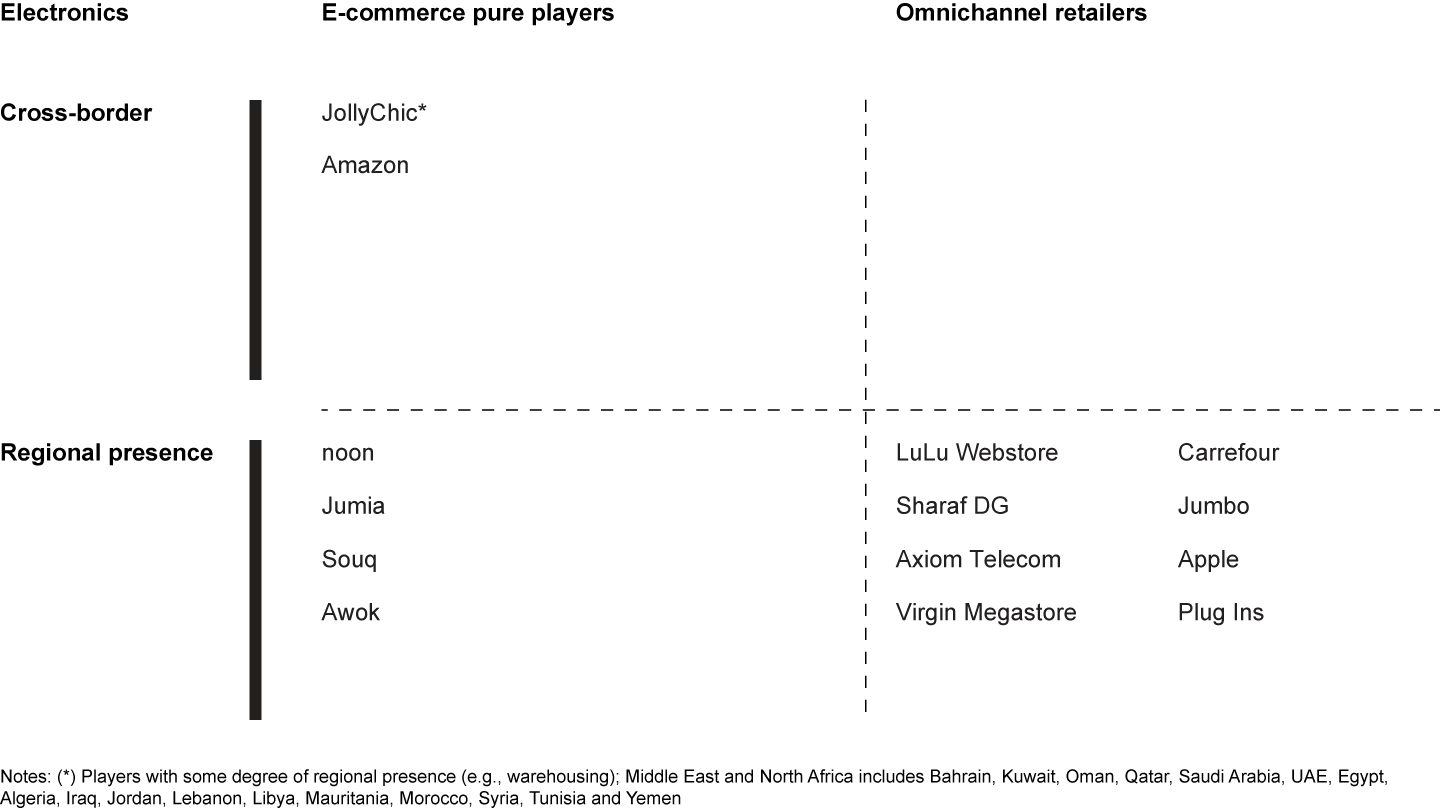
Fashion
Fashion e-commerce is valued at $1.1 billion in the GCC and Egypt, and it has been growing 20% annually over the past three years. The e-commerce share of total retail sales is at 2%, which is still relatively low compared with other developed e-commerce markets, such as the UK (25%) and China (31%), primarily due to limited product selection. Nearly 50% of online shoppers in the GCC and Egypt have bought fashion items online at least once. At $107, the average basket size online is higher than the $95 in-store cart.
With almost $900 million, the high street fashion e-commerce market represented nearly 2% of total retail sales in this category in 2017. Shoes and women’s clothing are the biggest subcategories. Competition has been intensifying among regional and international e-commerce players. Namshi has been an early mover in shoes and clothing; the company is now facing significant competition from other regional e-commerce players, such as Souq and noon, especially in KSA. China-based e-commerce players, led by JollyChic and Shein, have built a strong market position over the past few years. Omnichannel retailers have also increased their presence, with Landmark Group, Chalhoub Group, Al Tayer Group and Apparel Group launching new e-commerce channels and making a dent in the market (see Figure 13).
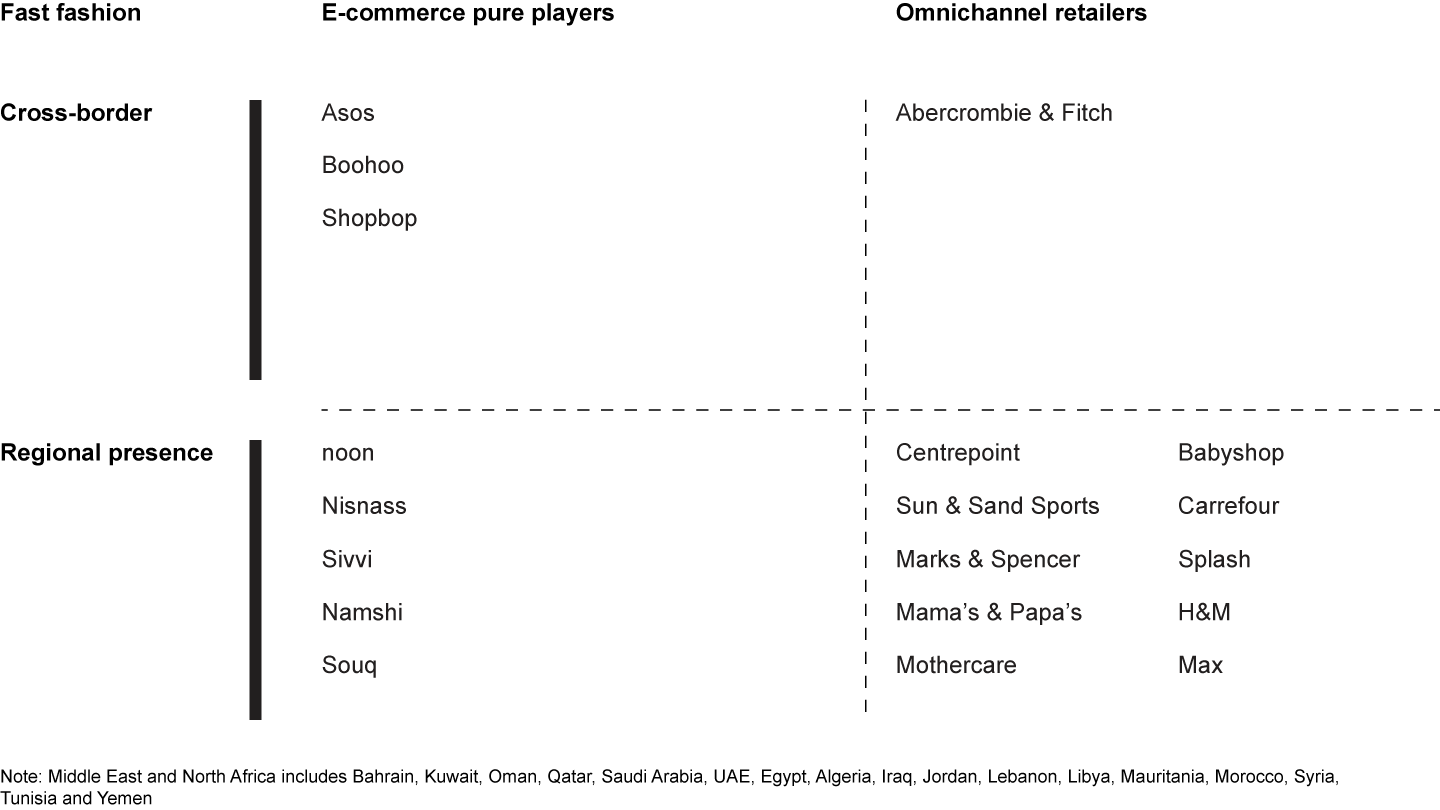
With an estimated $200 million market, luxury fashion e-commerce has been developing at a faster pace than high street fashion. It represents 7% of total luxury retail sales. Traditionally dominated by global luxury e-commerce pure players such as Net-A-Porter and Farfetch, regional omnichannel retailers have been catching up, with Ounass and Level Shoes gaining significant traction. The Chalhoub-Farfetch and Alabbar-YNAP partnerships should fuel market growth and provide more product options for MENA shoppers (see Figure 14).
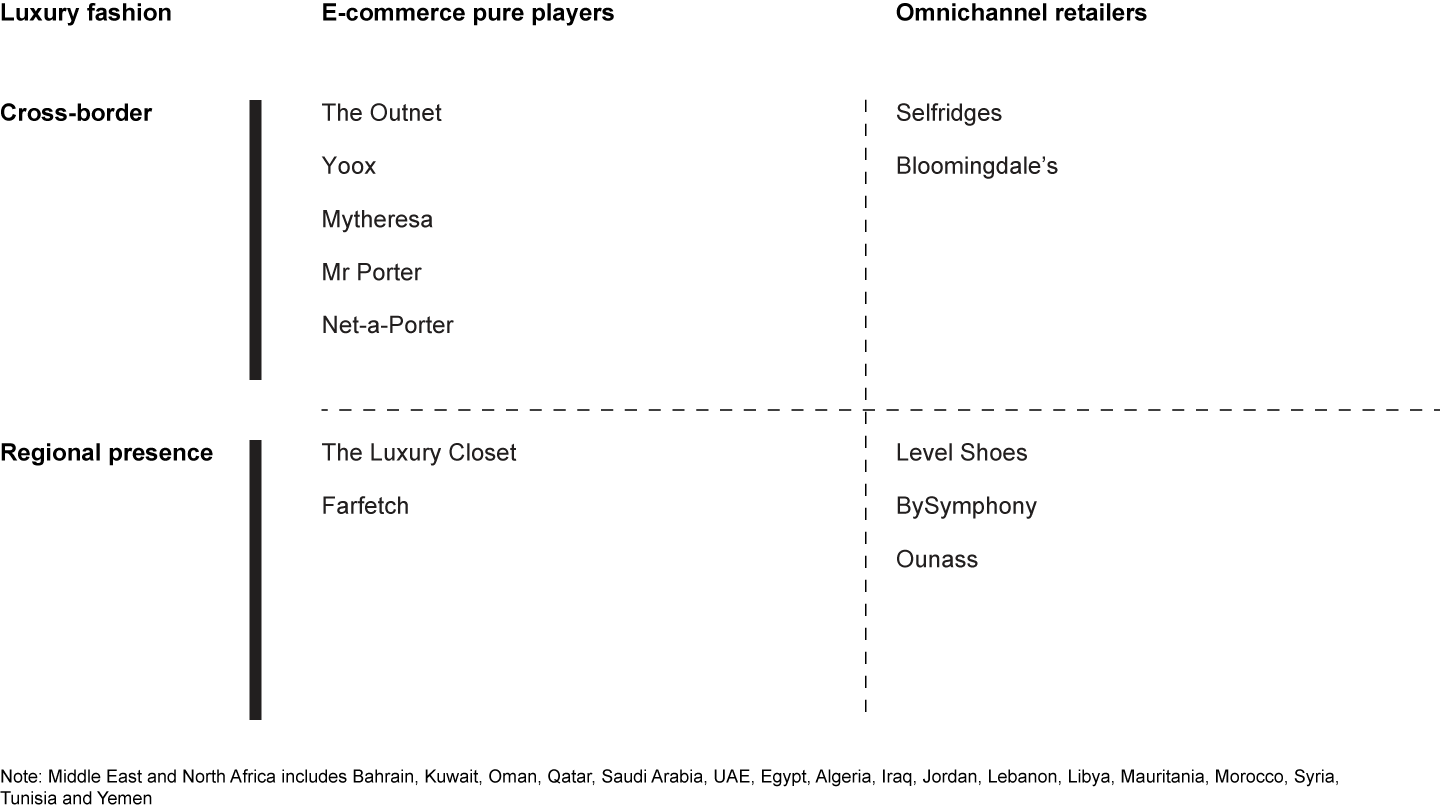
Beauty and personal care
Beauty and personal care is the second most highly penetrated category in the region, with an e-commerce market size of around $1 billion in the GCC and Egypt. And with an e-commerce share of total retail sales at 11%, the regional category is ahead of most developed e-commerce markets, such as the US and UK, which stand at 8% to 9%. The luxury beauty segment represents a fifth of the market, estimated at $200 million.
Increasing consumer confidence in the authenticity of underlying products, an area of focus for the main category players, has enabled growth in beauty. The introduction of Arabic beauty brands has boosted the category further. For example, Namshi launched a beauty and fragrance division in 2015, and Souq partnered with Rasasi Perfumes to expand its oriental fragrance selection in 2016. Social media and the increasing popularity of influencers have played a critical role in driving consumer engagement and online sales traction. Huda Kattan, for example, has established a significant presence on YouTube (2.4 million subscribers; 100 million video views) and managed to build a prominent beauty brand, Huda Beauty, that has been fueling demand online.
Nearly 60% of shoppers in the GCC and Egypt have bought beauty items online at least once, mainly using a smartphone (57% vs. 29% using a desktop). The average basket size has averaged $90 online vs. $59 for in-store sales.
Beauty e-commerce is facing significant competition among regional e-commerce pure players and omnichannel retailers. While Souq is the current market leader in the category, Sephora has established a very strong position in the segment. Competition has been intensifying with players such as Ounass, Wojooh, Estee Lauder, MAC, noon and Namshi increasing their market presence and China-based players such as JollyChic entering the market (see Figure 15).
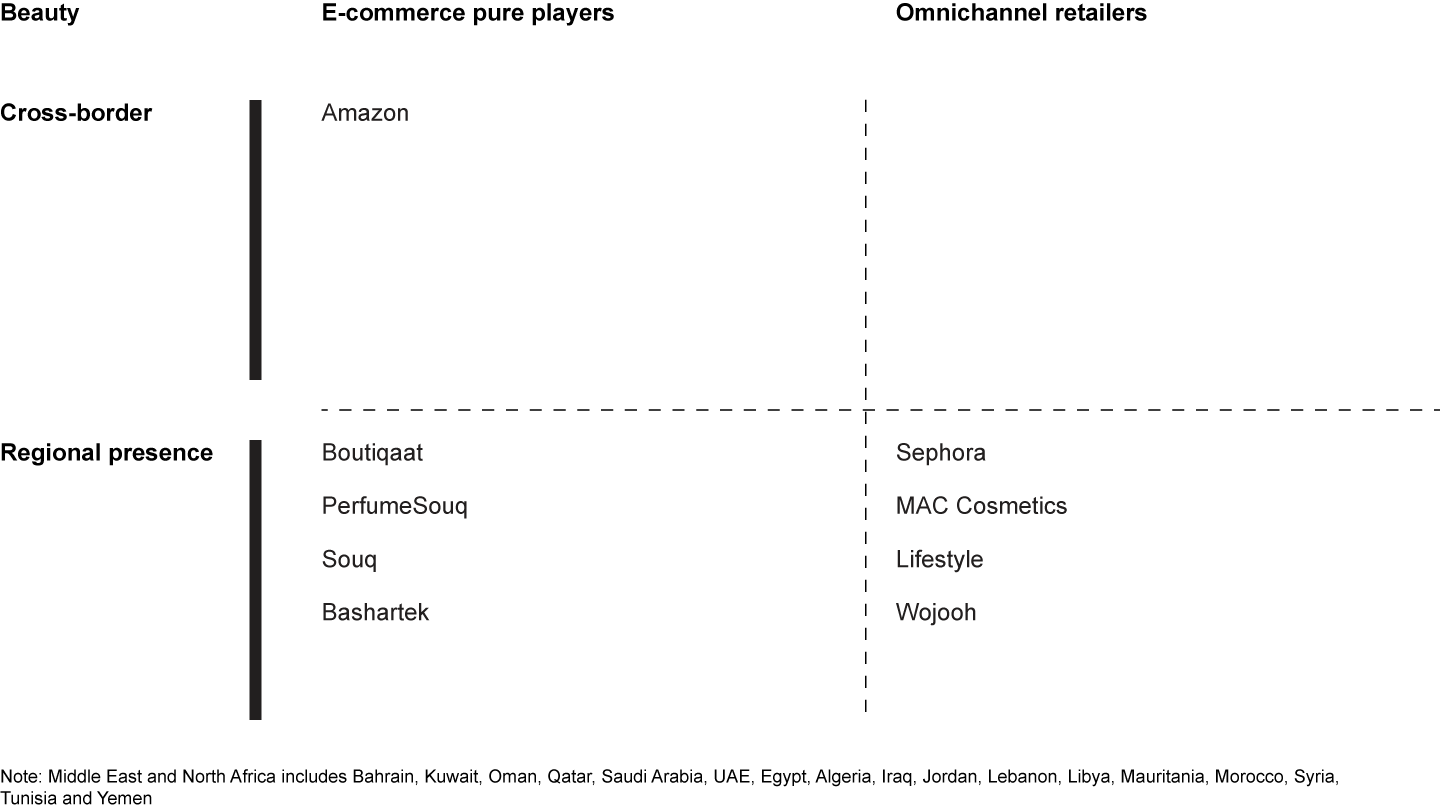
Grocery
Grocery has been the fastest-growing e-commerce category over the past three years at more than 250%. Despite the exponential growth, however, grocery remains the least penetrated retail category, with less than 1% of total category sales, as it is in most developed e-commerce markets. With an estimated e-commerce market size of nearly $200 million in the GCC and Egypt, nearly 60% of the region’s grocery shoppers have never bought from this category online, and the average basket size online ($144) is significantly higher than in-store purchases ($68).
Carrefour remains the category leader in the UAE, where it started its online operations. In addition, marketplaces have been gaining traction in MENA. Specifically in KSA, local baqalas have historically played an important role in the grocery market, and despite the related logistical challenges, the opportunity to bring these players online through marketplaces is significant. The culture of drive-through and phone delivery promises to make the transition to online shopping easier in MENA. A few players have shown progress in tackling this opportunity—namely, InstaShop, Trolley and El Grocer in the UAE; Todoorstep and Nana Direct in KSA; and Knockmart and Dakakyn in Egypt. Niche players with a unique value proposition are also active in the market—Sanadeeg for bulk orders and Kibsons for fresh produce and food items in the UAE. Multicategory players, such as Souq and noon, offer nonfresh groceries, but they have yet to launch perishables in their offerings (see Figure 16).
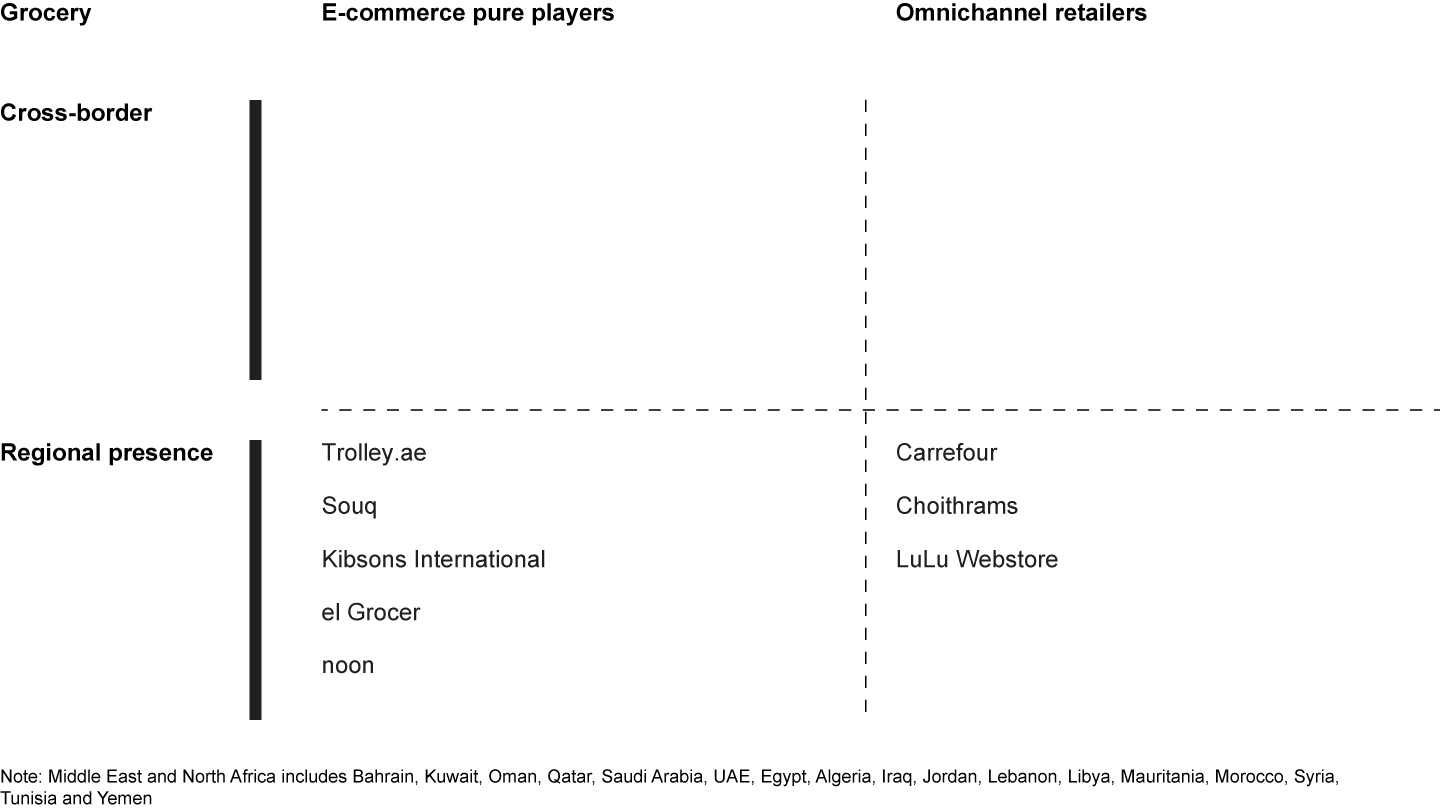
The future looks promising. Can MENA deliver?
Despite being late to take off, the MENA e-commerce market has gained momentum over the past couple of years, and it is set to experience significant growth should elements of the ecosystem continue to fall into place. The region is still in the beginning of the cycle of e-commerce adoption, and the future can take on many forms.
The growth trajectory of e-commerce has varied depending on the market. In well-established retail markets, such as the US, the growth of e-commerce has been linear, and it took more than two decades for e-commerce to reach a 12% share of total retail sales. In other markets, such as China, where the physical retail ecosystem has been historically underdeveloped, e-commerce growth has been significantly faster, with the e-commerce share of total retail sales growing to 14% in just eight years (see Figure 17).

Besides consumer readiness and the development of the different elements of the ecosystem, the entry of large e-commerce players could help accelerate the shift to e-commerce. India is a case in point. Prior to Amazon’s launch, the e-commerce market in India grew by 38% annually between 2009 and 2012. Following Amazon’s entry in 2013, India’s e-commerce market experienced a significant uplift. Growth in e-commerce more than doubled, averaging 88% annually between 2013 and 2016, while e-commerce penetration grew from 0.4% in 2013 to 1.8% in 2016. The launch of Amazon Prime in 2016 served as another catalyst, with e-commerce penetration growing to 2.5% the following year (see Figure 18).
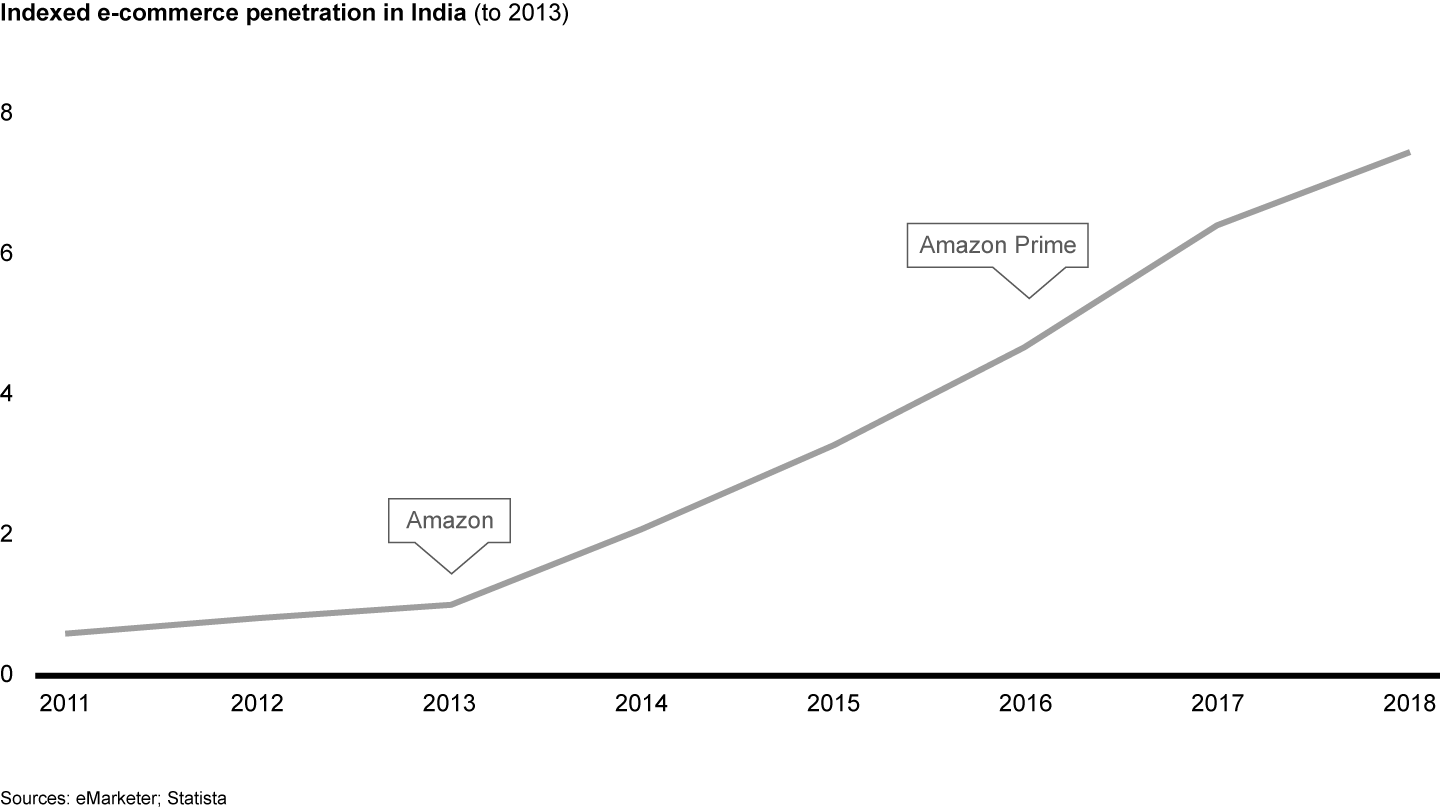
We estimate that the e-commerce market in MENA has the potential to grow 3.5 times by 2022, reaching a total market size of $28.5 billion and a penetration rate of 7% of total retail sales, similar to what is seen in continental Europe today (see Figure 19).
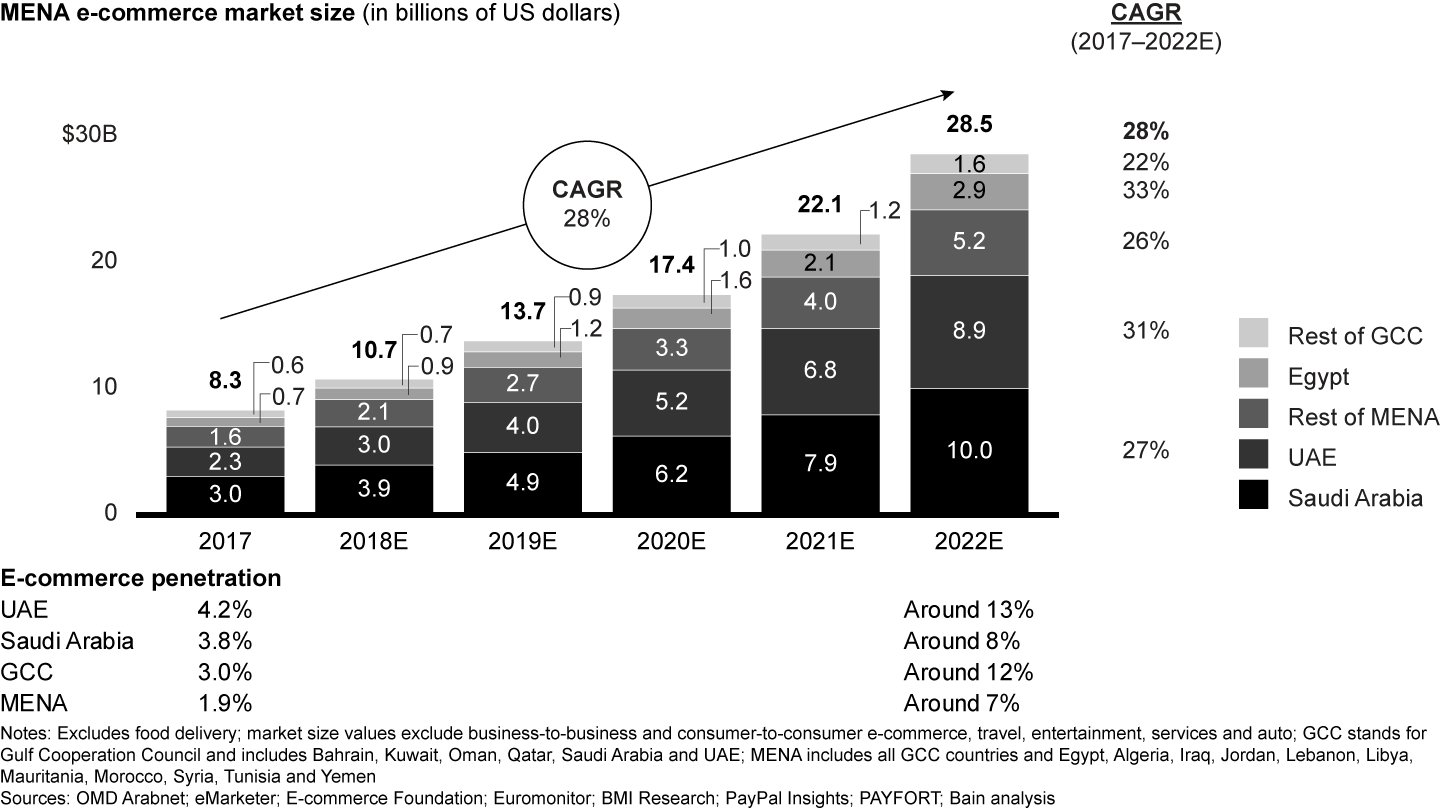
Our forecast calls for the KSA e-commerce market to grow by 27% annually, reaching around $10 billion by 2022, with a share of total retail sales at 8%. The expansion of the middle class, the growing role of women in the workforce, improvements in logistics, and access to online products in Tier 2 and Tier 3 cities represent key drivers for the growth of the market.
“E-commerce has given us access to a whole new set of customers in remote regions, which are our fastest growing areas today.” Abdulkarim A. Alagil, CEO, Jarir Bookstore
We forecast that the UAE e-commerce market will grow by 31% annually, reaching $9 billion by 2022, and we expect broader product selection, the entry of new players and innovation in business models to play key roles in this growth.
In Egypt, we see e-commerce growing by 33% annually and reaching $3 billion by 2022. Increased Internet penetration and the expansion of product selection from new local and existing regional players as well as improvements in logistics and payment infrastructure are some of the key growth enablers (see Figure 20).
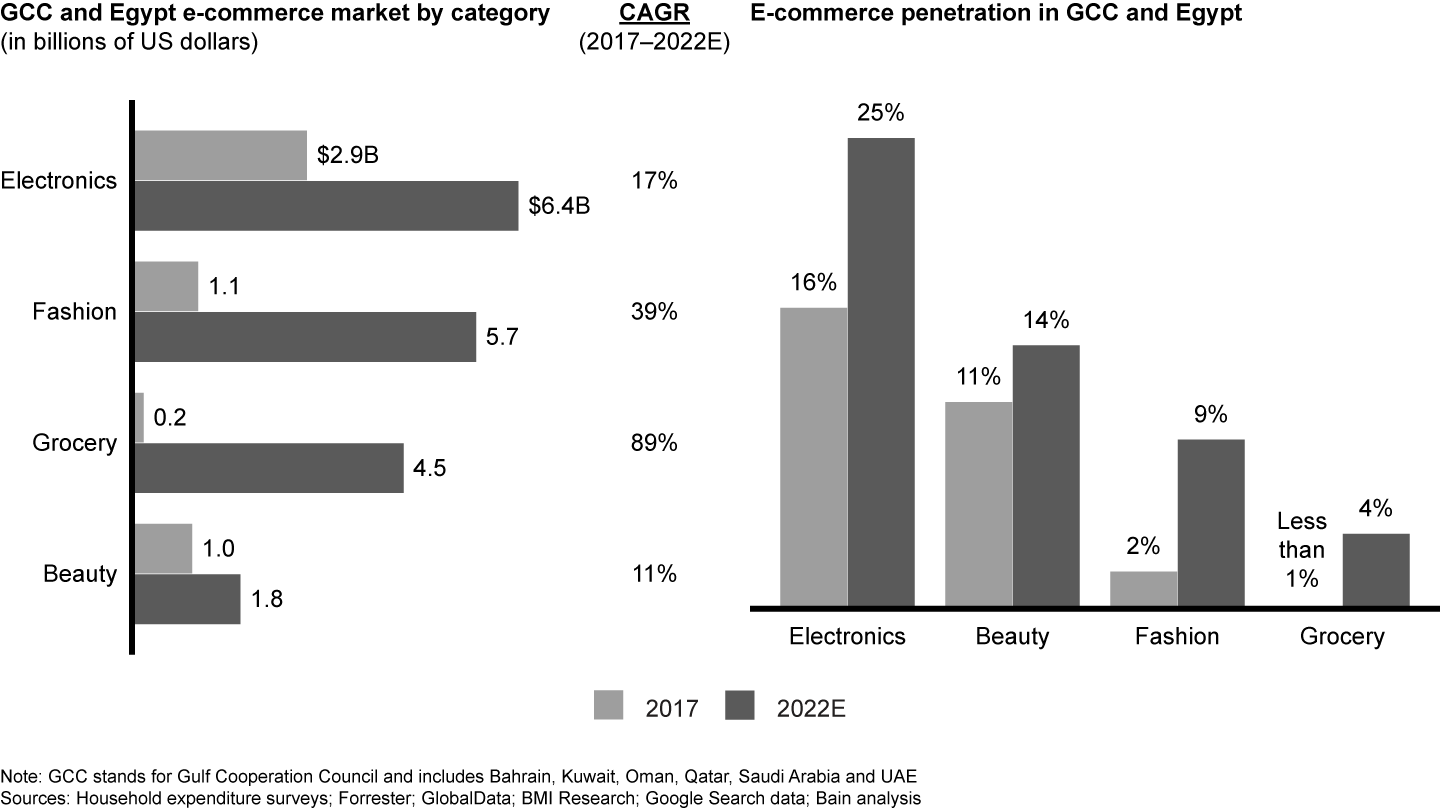
We expect electronics e-commerce to grow to $5.9 billion in the GCC and Egypt by 2022, with a share of total category sales of 25%. With markets such as the UK and US recording more than 40% penetration in this category, the room for growth in the region is significant. An expansion of product selection, beyond mobile phones and into home appliances, would be key. Omnichannel retailers taking a more active role, especially hypermarkets with well-established physical distribution networks, can help solve some of the logistical issues associated with this category.
We forecast that fashion e-commerce will grow by 40% annually and reach $5.1 billion in the GCC and Egypt by 2022, a penetration rate of 10% of total category sales. A broader product selection, faster deliveries and streamlined return policies can help unlock the potential in this category.
In the GCC and Egypt, we expect beauty e-commerce to reach $1.8 billion by 2022, with a share of total category sales of 14%. Growth catalysts include increased customer confidence in product authenticity, global players entering the space and geographical expansion to new cities, especially in KSA.
We see the grocery e-commerce category growing by almost 90% per year and reaching $4.1 billion in the GCC and Egypt by 2022, with a share of total category sales of 4%. A more aggressive expansion strategy by hypermarkets, further transition from the region’s drive-through and phone delivery culture to online marketplaces, and a broader geographic expansion to new cities would help facilitate market growth.
Further development in the ecosystem is key
Over the past few years, MENA has experienced significant progress in addressing some of the issues related to the e-commerce ecosystem. However, quantum leaps are necessary in some areas, such as payments and logistics, to foster healthy long-term growth in the e-commerce market.
Payments
Cash on delivery (COD) has been one of the biggest challenges for e-commerce in MENA. COD leads to higher return rates and failed deliveries, and it adds pressure to working capital requirements while limiting delivery options to logistics companies that accept this form of payment.
Today, around 62% of MENA online shoppers prefer COD as a payment method when buying online, compared with less than 5% in the UK and France. COD is prevalent even in the UAE, where credit card penetration is at 57%, which is higher than in the UK and France (see Figure 21).

To a large extent, MENA is still a cash-based economy, even in markets with healthy credit card penetration rates such as the UAE, where an estimated 75% of the economy is still cash based. COD seems like a natural extension of in-store payment habits, but it is also rooted in a consumer trust issue regarding online payments that is typical of emerging markets.
A consumer survey that we conducted in 2018 shows that the main reason for COD use is consumers’ preference to pay once they have the product in hand. One can attribute this to a general inconsistency in the consumer experience when shopping online—for instance, getting the right product delivered and the level of confidence in the return process. While a MENA online shopper typically uses his or her credit card to pay for online transactions with well-established cross-border e-commerce players, the same shopper prefers to pay in cash when presented with the option of shopping with regional players (see Figure 22).
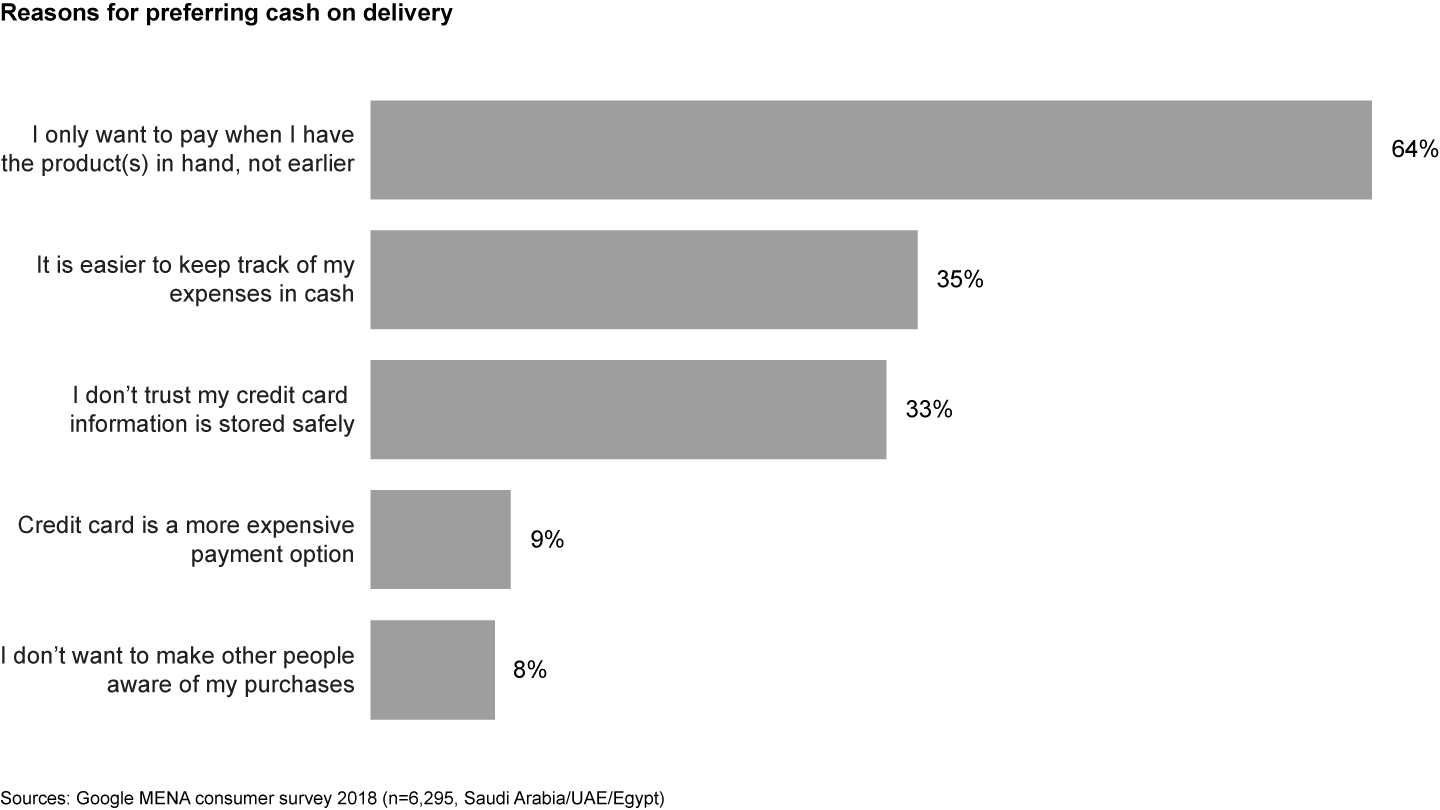
Establishing a consistent track record of product delivery that matches consumer expectations and a simple, fast and reliable return process are crucial components for addressing this issue over the long term. Building a brand that connects with consumers and inspires confidence on the basis of consistent experience over time could also help. Some omnichannel retailers that established this type of relationship in the physical world are reporting disproportionately higher rates of credit card payments, averaging 80% in the UAE for selected segments.
Mobile wallets have the potential to help address the COD challenge in MENA. As smartphones capture the majority of e-commerce transactions in the region, mobile wallets offer a more secure and convenient way to pay when compared with credit cards, though the inconvenience of inputting credit card details on mobile can encourage consumers to opt for COD. Its ease of use promises to alleviate consumers’ bias for cash payments not only at the time of purchase but also at the time of delivery, which would help address the cash part of COD.
Mobile wallets have been gaining traction in the market, with global tech players, telecom operators and local banks rolling out solutions and driving merchant and user adoption. Favorable legislation and government initiatives are keys to supporting the adoption of mobile wallets. Earlier this year, the UAE launched the Emirates Digital Wallet in partnership with 16 national banks. In 2016, the Central Bank of Egypt enacted regulations aimed at expanding the use of mobile payments and established the National Payment Council in 2017 to promote digital payments. Fawry’s mobile wallet now has around 4 million users in Egypt and promises to help enable digital payments, even for unbanked consumers using cash top-up. In addition to allowing debit card payments for online transactions (which enables banked consumers without credit cards to shop online), the Saudi Arabian Monetary Authority launched SADAD Accounts in 2016 as a safe and cashless alternative for online payments.
MENA’s payment challenges are typical of many emerging markets. In India, where 50% of the population has a bank account and 4% of adults have credit cards, cash accounts for more than 80% of online transactions. Both the private sector and the government are working to solve the payment challenges. While Paytm has established itself as the leading mobile wallet solution, the government launched the Unified Payments Interface in 2016 to support mobile peer-to-peer transfers.
In China, Alibaba’s Alipay played a key role in promoting cashless e-commerce by providing an escrow payment service that reduces transaction risk for online shoppers, who have the ability to verify whether they are happy with their purchased goods before releasing funds to the seller.
Logistics
Challenges related to the speed and cost of product delivery in MENA have hindered the development of e-commerce. In the UAE and KSA, the estimated average cost of package delivery is more than three times the global best practice for similar delivery times. With higher rates of returns and failed deliveries (five times the global best practice), COD-based deliveries are estimated to be twice as expensive as prepaid orders.
Postal services, the backbone of e-commerce delivery operations in most developed markets, are generally underdeveloped in MENA. Most global couriers, such as FedEx and DHL, do not offer COD, limiting delivery options to regional and local players. This has affected the speed and cost effectiveness of last-mile delivery, putting pressure on large regional multicategory e-commerce players to build their own last-mile delivery infrastructure. Souq’s QExpress has grown to become one of the largest delivery players in the region. Noon has also been building its last-mile delivery infrastructure and now employs more than 1,000 drivers across 20 cities. While Aramex remains the leading cross-regional logistics player, new local logistics players have mushroomed across markets, offering third-party delivery services. Inspired by Alibaba’s Cainiao, there is an opportunity to create a virtual regional logistics platform that could connect the different local delivery players to a cloud-based network that optimizes (time and cost) parcel delivery between sellers and buyers. It would also allow for an efficient handover of parcels among delivery players, especially for cross-border shipments.
Most MENA countries suffer from poor addressing systems that directly impact delivery speeds and failure rates. A number of players, such as Fetchr, have been innovating in the space by using con- sumers’ smartphones as their delivery addresses—namely, delivering to the users wherever they are. The company raised more than $50 million to acquire new businesses and scale operations.
The absence of land customs clearance for e-commerce shipments among neighboring countries in the region has led to the prevalence of more expensive air shipments. Establishing an Arab digital trade region that facilitates land customs clearance and eases customs clearance requirements would fuel the growth of cross-border e-commerce among MENA markets.
Conclusion
There has never been a better time to be in e-commerce in MENA. The market is at $8.3 billion today and estimated to reach $28.5 billion by 2022. The region’s digitally savvy consumers are hungry for a broader online product selection and new shopping experiences. E-commerce is at the core of retailers’ strategies, and e-commerce pure players are expanding into new markets and product categories. The different elements of the e-commerce ecosystem—namely, payments and logistics—have come a long way despite the many remaining challenges.
Building on the strong momentum of the past couple of years, e-commerce enters a pivotal time in the region. The opportunity is significant for consumers, businesses, investors and ecosystem players. Exponential or linear, the pace of growth will depend on how fast the three Ps—product selection, payments and product delivery—come together. When it comes to consumer Internet adoption and digital media investments, exponential growth has been a common theme in the region. Will history repeat itself?
Glossary
Brick-and-mortar players: Retailers with a physical presence/location that may have e-commerce capabilities but that do not meet all the requirements to be omnichannel
CAGR: Compound annual growth rate
E-commerce players: Retailers with an online presence, including e-commerce pure players, brick- and-mortar players, and some e-commerce presence and omnichannel players
E-commerce pure players: Retailers that operate only on the Internet (online) and have no physical presence/location
GCC: Gulf Cooperation Council, consisting of six nations—the Kingdom of Saudi Arabia, the United Arab Emirates, Kuwait, Qatar, Bahrain and Oman
Omnichannel players: Retailers that provide a seamless integration of physical and digital worlds to deliver an outstanding customer experience





















